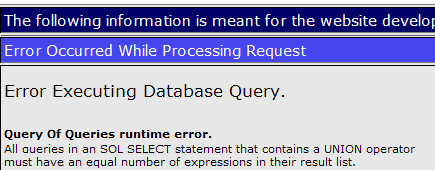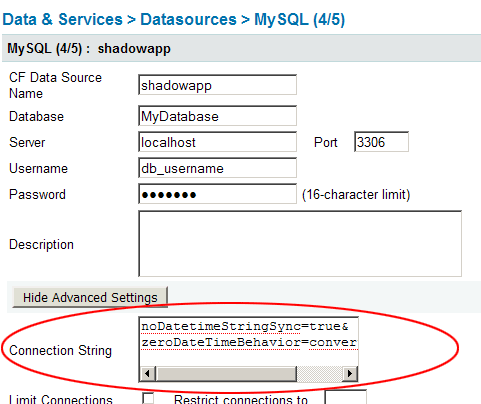Sometimes when writing JavaScript I need to have something run as soon as the page has finished loading. This is usually done by placing a call to the function in the body’s onload attribute like:
<body onload="myFunc()">
But this is not always possible. For example by the time you get to your logic that decides it necessary to call a function onload, the header may have already been displayed by a cfinclude or by your framework.
You could use JavaScript to set the onload event, like
window.onload = myFunc;
But what if there was already something in the onload attribute of the body tag? The above code will reset whatever was there. But here is a nice snippet of code that will add functions to the onload event. I can’t take credit for it, and I don’t remember exactly where I found it but its been quite useful to me. It works in all the popular browsers.
function addLoadEvent(func) {
var oldonload = window.onload;
if (typeof window.onload != 'function') {
window.onload = func;
} else {
window.onload = function() {
if (oldonload) {
oldonload();
}
func();
}
}
}
Then you can add as many functions as you want to be called when the page loads. Note you do not use parenthesis when specifying the function names – you aren’t calling then, just referencing them.
addLoadEvent(myFunc);
addLoadEvent(myFunc2);
addLoadEvent(yetAnotherFunction);
Posted by Ryan Stille on April 27 2009 at 10:47 am under AJAX / JavaScript, Web Development.
4 Comments.
The other day I had a need to be creating dates in a SQL Server SQL statement, made from a few different text fields. I could not find a function to create a date from these, so I wrote one (with the help of our in house SQL guru).
Continue reading ‘A ‘MakeDate’ function for MS SQL Server’ »
Posted by Ryan Stille on April 2 2009 at 9:14 pm under SQL, Web Development.
2 Comments.
Railo 3.1, the much anticipated open source release of the Railo CFML engine was released yesterday. I’ve been playing with it the last two evenings. So far I’m very impressed. They have an “Express” version which you can get running almost instantly. I tried that, but then opted to get it working as I would for a real site – using Tomcat and Apache. It was much easier than I thought.
The administrator is very full featured with everything you would expect – scheduled tasks, ability to create database connections to MySQL and MSSQL (among several others), and search! Railo has Apache Lucene built right in. Creating a new Lucene index is as easy as creating Verity collection in Adobe ColdFusion. The cfsearch/cfindex tags work like you would expect them to, with a few exceptions. You can even populate and search the collection right from within the administrator.
I was happy to see that you can define multiple SMTP servers. Railo will try each of them in order if any of them are unavailable.
I also really like the way Railo has done the administrator – with one global administrator (called the server administrator) and then administrators for each site (called a web administrator). I think this is going to make it much easier for hosting companies to offer CFML support.
Posted by Ryan Stille on April 1 2009 at 9:36 pm under ColdFusion, Railo, Web Development.
2 Comments.
I just finished one of the books I received for Christmas, More Joel on Software by Joel Spolsky. This book is the 2nd compilation of blog articles from Joel’s popular software development blog.
I really enjoyed this book. I was surprised how often Joel had me laughing out loud, he really is a good writer. The book is broken down into nine sections.

- Managing People
- Advice to Potential Programmers
- The Impact of Design
- Managing Large Projects
- Programming Advice
- Starting a Software Business
- Running a Software Business
- Releasing Software
- Revising Software
Joel has a lot of experience in programming and in running a software business, and has lots of interesting stories to tell. In fact chapter one is titled My First BillG Review, its a story about Joel’s first meeting with Bill Gates, where Bill reviewed Joel’s 500 page spec on Excel Basic.
Joel covers a lot of interesting topics, including finding and keeping great developers, different management styles, running a software business, and revising code.
I especially liked his thoughts on estimating. He uses something called Evidence Based Scheduling. EBS is a system where you keep track of estimated hours vs actual hours. The math gets a little complicated, you can read about in detail on Joel’s site (or the book), but basically its a way to accurately estimate projects. Regardless of if the developer estimating tends to over or under estimate, the formula works all this out. It sounds like a really neat system. Joel’s popular project management software FogBugz supports EBS.
All the content of the book is available on his blog for free, but it is nicely organized in the book and it has some updates. Its a bargain at $16 on Amazon, and I enjoy reading stuff like this in book format rather than on a computer screen. This is a book that I will be hanging on to.
Posted by Ryan Stille on March 28 2009 at 11:00 pm under Book Reviews, Web Development.
Comments Off on Book review: More Joel on Software.
I was trying to execute a .cfm page on a new CentOS 5.2 server and I received this error. Not all requests were erroring out, the CF Administrator was working fine as were other simple pages. But when I tried to load a page that instantiated some java objects, I got this error.
"coldfusion.jsp.CompilationFailedException: Errors reported by Java compiler: jikes: error while loading shared libraries: libstdc++.so.5: cannot open shared object file: No such file or directory
I checked to make sure libstdc++ was installed, and it was, although not version 5. I checked another one of our Linux CF8 servers, it didn’t have version 5 installed either, so I didn’t think that was the problem. I noticed the other server had some compat libs installed that I was missing though. I ran this command: yum install compat-libstdc\* which installed two RPMs: compat-libstdc++-296 and compat-libstdc++-33. Then I restarted ColdFusion, and was able to execute the page with no errors.
Posted by Ryan Stille on February 6 2009 at 11:10 am under ColdFusion, Linux, Web Development.
Comments Off on coldfusion.jsp. CompilationFailedException: jikes error on CentOS 5.2.
Update 8/27/09: I am available for consulting to help with this issue, I’ve helped quite a few people out already. My rate is $75/hr, and you can contact me at ryan@stillnet.org. -thanks
If you use the CFX_PayFlowPro tag to connect to PayPal’s PayFlowPro service (formerly owned by Verisign) you should be aware that it will stop working in September of 2009. You must transition to one of their newer connection methods before then.
Here is a drop in replacement custom tag you can use. You should be able to pretty much just change your code from “CFX_PayFlowPro” to “CF_PayFlowPro”. If you run into any issues and end up modifying the tag, please let me know and I’ll get the changes worked back into the original.
Continue reading ‘CFX_PayFlowPro to stop working in 2009 – here’s a drop in replacement’ »
Posted by Ryan Stille on February 2 2009 at 10:29 am under Web Development.
142 Comments.
There may be something buggy here, or maybe I’m misunderstanding how this should work.
This code executes fine:
<cfquery name="qryListings" dbtype="query">
SELECT 1 as OrdBy, * FROM qryListings
UNION
SELECT 2 as OrdBy, * FROM qryListingsTmp
ORDER BY OrdBy
</cfquery>
But when I add a WHERE clause to the second part to filter out records that were in the first group:
<cfquery name="qryListings" dbtype="query">
SELECT 1 as OrdBy, * FROM qryListings
UNION
SELECT 2 as OrdBy, * FROM qryListingsTmp WHERE ref_num NOT IN
(#ValueList(qryListings.ref_num)#)
ORDER BY OrdBy
</cfquery>
I get a ColdFusion error about the number of columns being different between the two queries.

Continue reading ‘A bug with Query of Query and * ?’ »
Posted by Ryan Stille on January 20 2009 at 7:32 pm under ColdFusion, SQL, Web Development.
1 Comment.
Sometimes its helpful to allow users to dynamically add or remove elements from a form. An example might be an image upload page, where you want to allow users to upload a varying number of images. Using JavaScript you can easily place more/less links on the page that show and hide form elements.
This is often done by placing a large number of elements on the form, and setting most of them to be initially hidden with CSS. When the user clicks the “show” link, the next element is unhidden. This is not the best solution however, especially when there is a possibility of having tens of elements – thats a lot of unnecessary html to send down the pipe and render.
Another method is to actually create and destroy elements using the DOM functions. Here’s how I did this recently on a page that need to have any number of form elements.
Continue reading ‘Dynamically adding and removing form elements’ »
Posted by Ryan Stille on January 5 2009 at 11:34 am under AJAX / JavaScript, Web Development.
18 Comments.
I had the need to instantiate some static nested Java classes, from within ColdFusion. I was doing some searching through IMAP. The Java code I was trying to emulate went something like this:
import javax.mail.*;
import javax.mail.internet.*;
InternetAddress address = new InternetAddress();
SearchTerm toTerm = new RecipientTerm(Message.RecipientType.TO, address);
SearchTerm ccTerm = new RecipientTerm(Message.RecipientType.CC, address);
SearchTerm bccTerm = new RecipientTerm(Message.RecipientType.BCC, address);
SearchTerm[] recipientTerms = {toTerm, ccTerm, bccTerm};
SearchTerm orTerm = new OrTerm(recipientTerms);
Continue reading ‘Instantiating Nested Static Java Classes from ColdFusion’ »
Posted by Ryan Stille on November 22 2008 at 5:27 pm under ColdFusion, Web Development.
1 Comment.
I ran into this issue when adding a new datetime column to an existing table in my MySQL 5 database. I did not get the error in my production environment, only the dev environment on my local machine.

I was puzzled by this error, because I thought the all zeros value basically meant a null/unknown date value. Also I wasn’t using a type TIMESTAMP, I was using a DATETIME column type, so that threw me, too. After digging through the data a little bit, I found that the values for these new columns in the production database were NULL, but the values in my dev database were ‘0000-00-00 00:00:00’. A little googling told me that the all zeros value is what happens when an invalid date is assigned to a datetime field.
I could not see any differences in the schema, so I’m not sure how this happened. But updating my dev data to be NULL where the value was ‘0000-00-00 00:00:00’ solved the problem.
The other option, if you can’t change your data, is to add these items to your connection string value in the ColdFusion Administrator for your datasource:
noDatetimeStringSync=true&zeroDateTimeBehavior=convertToNull

This tells MySQL to return a null instead of throwing an exception when one of these values is found. This is how I initially solved the problem, until I figured out that ‘0000-00-00 00:00:00’ was not a proper value.
Posted by Ryan Stille on November 20 2008 at 8:14 pm under ColdFusion, SQL, Web Development.
2 Comments.





